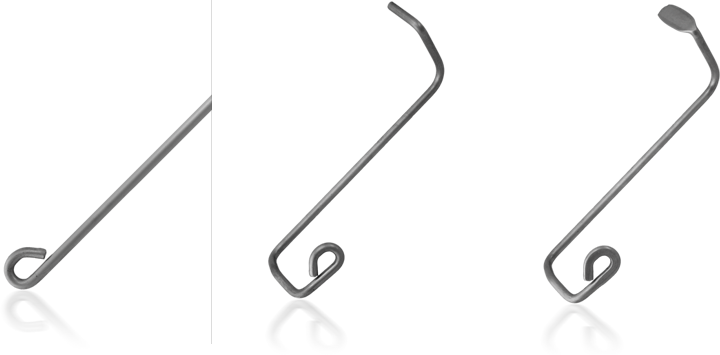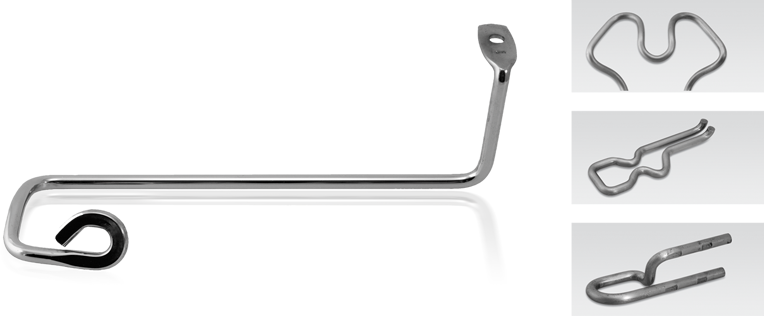| Stage I | Stage II | Stage III |


End stage
Diameter 3/8“, 2 sec. cycle time, flattening of the eye at 180,000 lbs, flattening of the end at 360,000 lbs, left and right version, series runs from 20,000 parts, finished part falling out, power requirement approx. 30 kW
Bending
Bending is a very common step in the manufacturing processes of metal parts. Most metal parts are produced from raw materials with very simple shapes and profiles such as bars, wires, sheet metal, among others, which are then formed into the desire result.
Metal bending can be performed as a hot forming process or as a cold forming process. However, hot bending must be carefully performed, and it is more specific for certain applications because of the modifications that are introduced to the structure of the material due to the high temperatures required.
On the other side, cold bending is a more common process performed on sheet metal parts or metal parts with small cross sections such as those produced from metal wire, as they are ductile enough to be shaped by means of slides and presses without any problem.
How is cold bending performed?
As it was mentioned before, cold bending is usually performed by using the force of a slide, finger bender or press. The piece of metal being formed is positioned on a die that will define the end shape of the part. Then, the metal is pressed on the die by the force of the bending unit to achieve the final shape.
Of course, the final shape will depend on different factors such as the shape of the die, the attack angle of the units force and how the piece of metal is positioned on the die. Schmale does cold bending operations up to 1” wire diameter.
How can the most complex shapes be achieved?
To produce the most complex shapes, it may be necessary to rely on the expertise of the operator, and the operator may need to perform more than one pressing operation. In addition, it could be necessary to change the die to achieve the desire results.
If we consider all this process and the fact that the ready part requires more than just bending, for example threading, flattening, swaging, and other processes, it is clear that the time to market for the part will be extended and the production costs will be increased.
To avoid those negative aspects, Schmale Machinery offers fully automated solutions for the bending process, allowing you to achieve a high level of efficiency and productivity. Moreover, Schmale machines integrate this process as a stage of an entire production cycle that can include other processes such as threading, swaging, welding and others.
Schmale automated solutions can bend wire with a diameter of up to 1″, which is fed into the production cycle by automatic servo-electric feeders. The entire cycle takes only a few seconds, and the wire automatically moves through the different processes to generate the expected results.
Series runs begin at 20,000 parts, which clearly represents an enormous increase in efficiency and productivity and a significant reduction in the time to market, meaning that the profitability of your business will be higher.
To have a better view of the process please refer to the pictures and videos.
If you are looking for a bending solution integrated in a fully automated production process, or you have any further questions, please do not hesitate to contact us and we will gladly help you.
